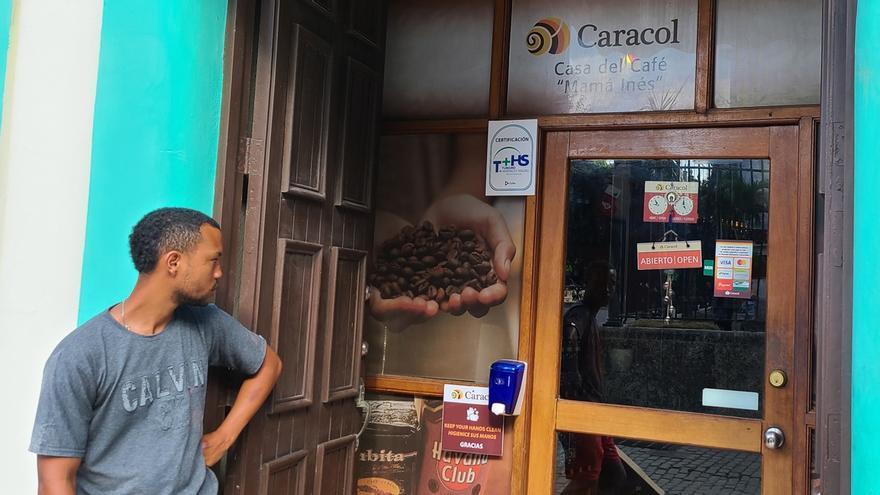
![]() 14ymedio, Havana, 6 December 2023 — “Error.” That word, appearing this Wednesday on the payment terminal screens at the Casa del Café Mamá Inés in Old Havana, destroys the illusions of the Central Bank of Cuba (BCC) about the effectiveness of the Russian Mir cards. Despite its commitment to the officials of the Russian National Card Payment System who visited this store belonging to the Caracol state group yesterday, electronic payment, according to its own employees, “is not working.”
14ymedio, Havana, 6 December 2023 — “Error.” That word, appearing this Wednesday on the payment terminal screens at the Casa del Café Mamá Inés in Old Havana, destroys the illusions of the Central Bank of Cuba (BCC) about the effectiveness of the Russian Mir cards. Despite its commitment to the officials of the Russian National Card Payment System who visited this store belonging to the Caracol state group yesterday, electronic payment, according to its own employees, “is not working.”
“The cards are implemented,” clarifies an employee of Mamá Inés to 14ymedio. “The problem is that, when you pass them, they give an error.” Excited about the premiere of the Mir cards, the BCC authorities published photographs of the Russian envoys, whose “purchase actions” were “satisfactory” and culminated their visit by placing, on the door of the premises, the sticker that indicates that one can now pay with Russian cards.
“Mamá Inés does not accept cash rubles, only Russian tourist cards. Not as many people come as they would like, but they do come,” explains the worker. However, the employee acknowledges, unless the Cuban trying to us the Mir system has a bank account opened in Russia, the card doesn’t work.
As indicated by the entrance sign, a customer can also pay with Visa, Mastercard or in freely convertible currency (MLC). The only thing that has been banished in Mamá Inés – managed by a franchise of the Island’s military – is the Cuban peso.
Mama Inés does not accept rubles in cash, only Russian tourist cards. Not as many people come as they would like, but they do come
What none of the employees of the Casa del Café has been able to determine is whether the failure that affects the Mir is general. The precariousness of the Internet connection, the blackouts and the slowness of electronic processes on the Island make every digital payment a nightmare. However, no foreign card has the political caliber of the Mir, in whose effective operation Havana plays one of the essential points of its alliance with Moscow: the digitization of the market, an indispensable step to better control it.
Decorated with photos of Ernesto Che Guevara, with shelves full of bottles of Cuban rum and some cartoonish images of a matriarch with a tray of cups and a coffee pot held above her head, the place includes all the stereotypes that have been used in Cuba for decades to widen the eyes of tourists. But, in addition to the clichés, this Wednesday’s customers were looking for realities.
El Galeón, a tobacco and coffee shop next to Mamá Inés, attests to this. A security agent, outside the establishment, prevents the passage of customers. As in the Casa del Café, there one can also pay with Russian cards, and a Cuban Television team is filming a report about the place.
There is no reason for Mir to be the exception to the disastrous panorama of electronic payment on the Island. It is common that, when using a Visa card issued by a European or American bank, customers are faced with the same error sign in the payment terminals. The Island’s bad connections prevents the purchase information from reaching the bank via the Internet, and it is common for devices to block the transaction for security reasons.
The Mir signal, which must travel over 6,200 miles from the tropics to Russia, is less likely to arrive than the signal of other cards, until Cuba has a less precarious telecommunications technology.
Whatever the reason, something is clear: Cuba is not ready for payment with Mir cards, and its infrastructure is not up to the aspirations of the authorities. The ideological vicinity of Havana and Moscow does not accelerate the speed of the transactions, which, at the moment of truth, are as slow as those activated with the “enemy” cards.
Translated by Regina Anavy
____________
COLLABORATE WITH OUR WORK: The 14ymedio team is committed to practicing serious journalism that reflects Cuba’s reality in all its depth. Thank you for joining us on this long journey. We invite you to continue supporting us by becoming a member of 14ymedio now. Together we can continue transforming journalism in Cuba.
